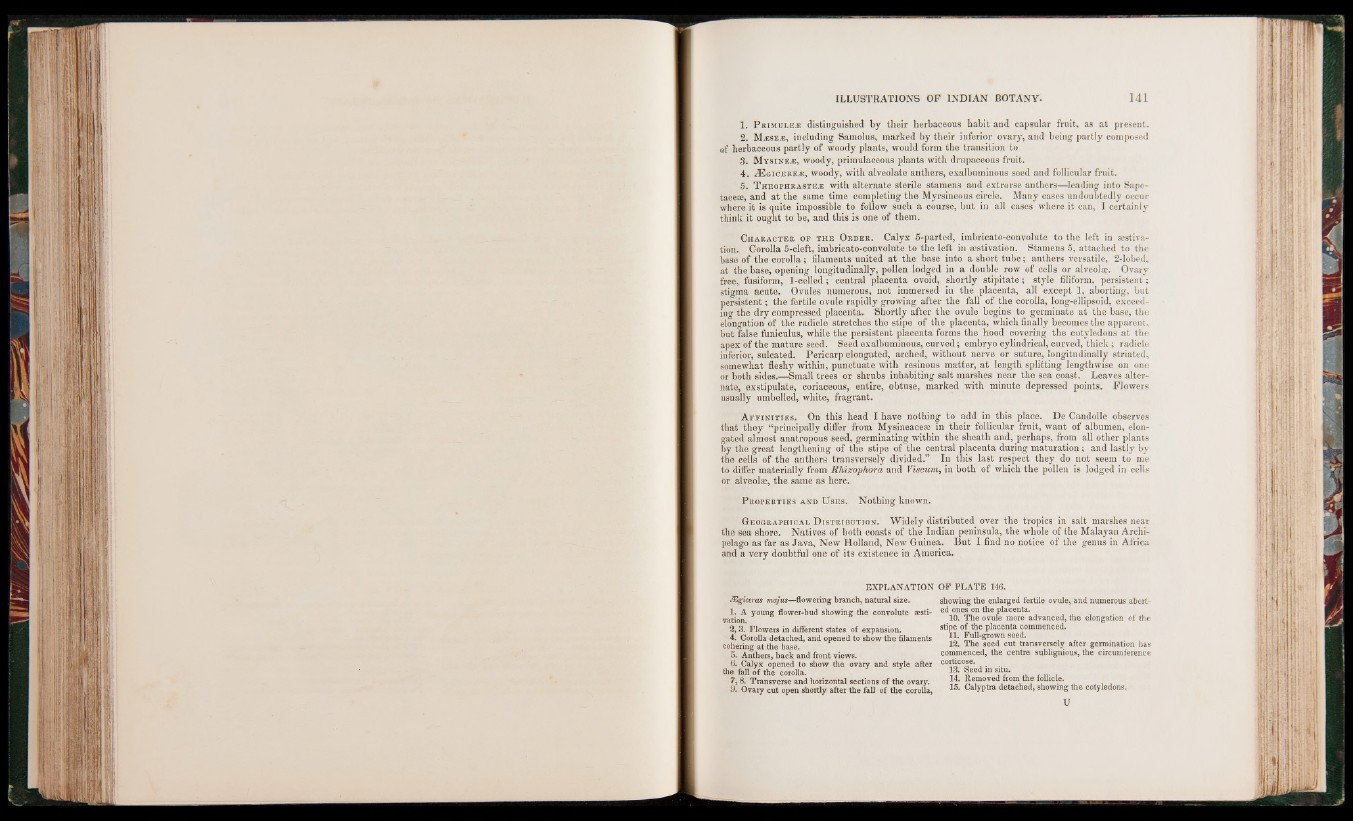
ILLUSTRATIONS OF INDIAN BOTANY.
1. P rimule^e distinguished by their herbaceous habit and capsular fruit, as at present.
2. Mjese,e, including Samolus, marked by their inferior ovary, and being partly composed
of herbaceous partly of woody plants, would form the transition to
3. Mysine^e, woody, primulaceous plants with drupaceous fruit.
4. /EGiCEREiE, woody, with alveolate anthers, exalbuminous seed and follicular fruit.
5. T heophrasteje with alternate sterile stamens and extrorse anthers—leading into Sapo-
tacese, and at the same time completing the Myrsineous circle. Many cases undoubtedly occur
where it is quite impossible to follow such a course, but in all cases where it can, I certainly
think it ought to be, and this is one of them.
Character of the Order. Calyx 5-parted, imbricato-convolute to the left in aestivation.
Corolla 5-cleft, imbricato-convolute to the left in aestivation. Stamens 5, attached to the
base of the corolla; filaments united at the base into a short tube; anthers versatile, 2-lobed,
at the base, opening longitudinally, pollen lodged in a double row of cells or alveola?. Ovary
free, fusiform, 1-celled; central placenta ovoid, shortly stipitate; style filiform, persistent;
stigma acute. Ovules numerous, not immersed in the placenta, all except 1, aborting, but
persistent; the fertile ovule rapidly growing after the fall of the corolla, long-ellipsoid, exceeding
the dry compressed placenta. Shortly after the ovule begins to germinate at the base, the
elongation of the radicle stretches the stipe of the placenta, which finally becomes the apparent,
but false funiculus, while the persistent placenta forms the hood covering the cotyledons at the
apex of the mature seed. Seed exalbuminous, curved; embryo cylindrical, curved, thick; radicle
inferior, sulcated. Pericarp elongated, arched, without nerve or suture, longitudinally striated,
somewhat fleshy within, punctuate with resinous matter, at length splitting lengthwise on one
or both sides.—Small trees or shrubs inhabiting salt marshes near the sea coast. Leaves alternate,
exstipulate, coriaceous, entire, obtuse, marked with minute depressed points. Flowers
usually umbelled, white, fragrant.
Af f in it ie s . On this head I have nothing to add in this place. De Candolle observes
that they “principally differ from Mysineacese in their follicular fruit, want of albumen, elongated
almost anatropous seed, germinating within the sheath and, perhaps, from all other plants
by the great lengthening of the stipe of the central placenta during maturation; and lastly by
the cells of the anthers transversely divided.” In this last respect they do not seem to me
to differ materially from Rhixophora and Viscum, in both of which the pollen is lodged in cells
or alveolae, the same as here.
P roperties and U ses. Nothing known.
Geographical D istribution. Widely distributed over the tropics in salt marshes near
the sea shore. Natives of both coasts of the Indian peninsula, the whole of the Malayan Archipelago
as far as Java, New Holland, New Guinea. But I find no notice of the genus in Africa
and a very doubtful one of its existence in America.
EXPLANATION
JEgiceras majus—flowering branch, natural size.
1. A young flower-bud showing the convolute aestivation.
2, 3. Flowers in different states of expansion.
4. Corolla detached, and opened to show the filaments
cohering at the base.
5. Anthers, back and front views.
6. Calyx opened to show the ovary and style after
the fall of the corolla.
7. 8. Transverse and horizontal sections of the ovary.
9. Ovary cut open shortly after the fall of the corona,
OF PLATE 146.
showing the enlarged fertile ovule, and numerous aborted
ones on the placenta.
10. The ovule more advanced, the elongation of the
stipe of the placenta commenced.
11. Full-grown seed.
12. The seed cut transversely after germination has
commenced, the centre sublignious, the circumference
corticose.
13. Seed in situ.
14. Removed from the follicle.
15. Calyptra detached, showing the cotyledons.
U